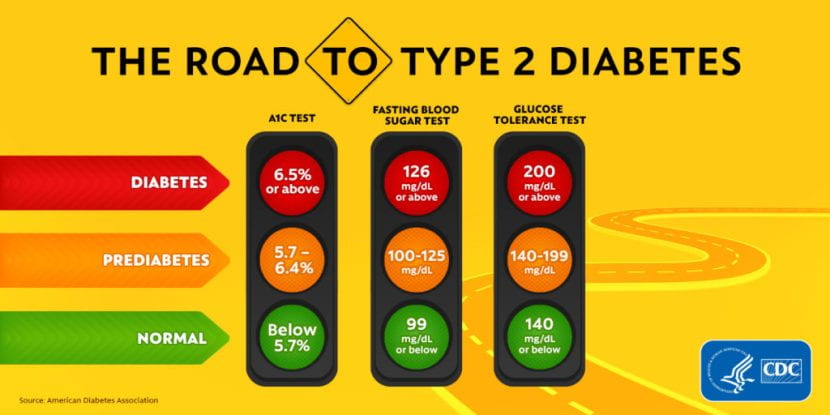Prediabetes is a condition which causes a person’s blood sugar level to be elevated, but not high enough to be considered Diabetes. In 1980, the American Diabetes Association introduced the criteria for Type 2 Diabetes and included Prediabetes in order to determine the likelihood of developing diabetes. A normal fasting blood sugar level is below 100, whereas the level of a person with prediabetes is between 100 and 126. Once levels have surpassed 126, it’s classified as Type 2 diabetes. This indicates that the body resists insulin or doesn’t produce enough of it to maintain normal blood sugar levels. Other names used for prediabetes are impaired fasting glucose, glucose intolerance, impaired glucose tolerance, and borderline diabetes.
Screening for prediabetes can be done as part of routine blood work. A doctor can make a diagnosis with a fasting blood glucose (FBG) test which measures your blood sugar after an overnight fast, or using a non-fasting hemoglobin A1c (HbA1c or A1c) test to measure an individual’s blood sugar levels over the past three months.
The following test results show Prediabetes
- A1c—5.7 to 6.4 percent
- FBG—100 to 125 mg/dL (milligrams per deciliter)
A fasting glucose test is part of a standard blood test and is commonly used to screen for prediabetes. However, since not everyone can fast before getting bloodwork, the A1C test is also routinely used.
If you or someone you know has been diagnosed with Prediabetes, you are not alone. According to the National Institute of Health (NIH), more than 84 million people, ages 18 and older, have prediabetes in the United States. That’s about 1 out of every 3 adults.
The NIH also reports that people with prediabetes have up to a 50 percent chance of developing diabetes over the next 5 to 10 years. You can take steps to manage your prediabetes and prevent type 2 diabetes. When your doctor tells you that you have prediabetes, you might think there’s no reason to take action just yet. Or you might assume that you’re surely going to get diabetes. Not so! You do need to take prediabetes seriously, but there’s still time to turn things around if you start now.
The goal is to get your blood sugar level below the prediabetes range and keep it that way.
What you do every day makes a big difference. Making lifestyle changes, such as reducing intake of processed foods, and increasing daily physical activity level, can be most impactful and beneficial to taking control of your health, and more specifically, your blood glucose.
Mayoclinichealthsystem.org
NIDDK.nih.gov
https://publichealth.jhu.edu/2022/what-is-prediabetes
All Blogs are written by Professionals in the fields of Nutrition, Human Development and Diabetes.
